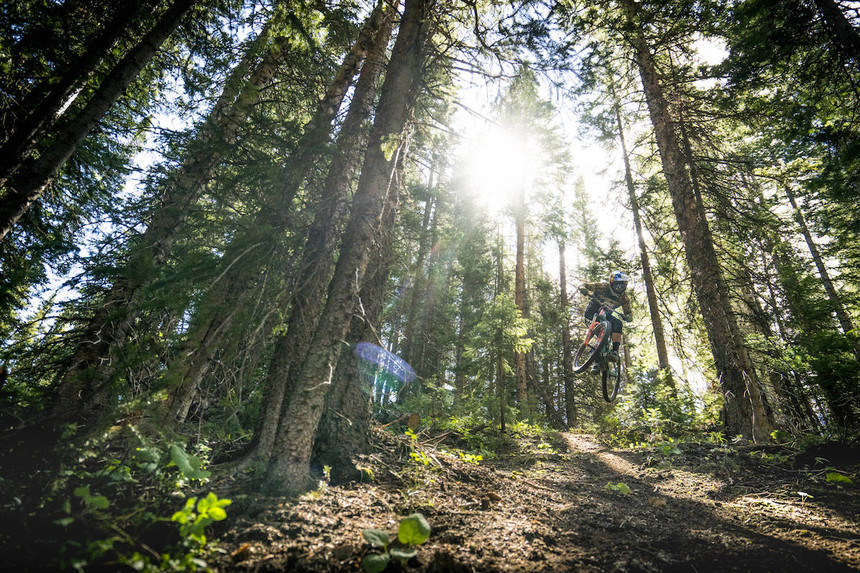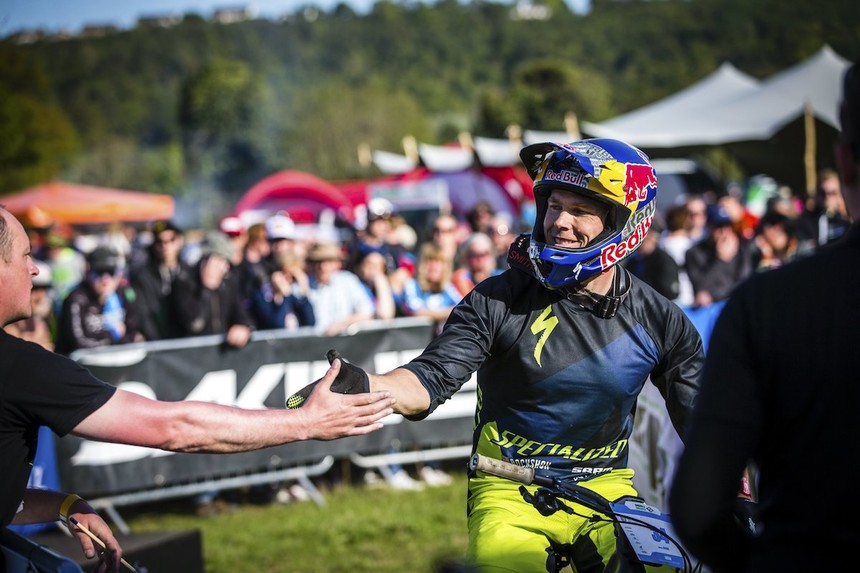 Racing and athletes like Aaron Gwin play a huge role in today's MTB trends. Red Bull photo.
Racing and athletes like Aaron Gwin play a huge role in today's MTB trends. Red Bull photo.
The history of mountain biking is littered with stories about the origins of the sport, and although bikes were ridden off road in the past, it wasn’t until the mid 1960s when a group of Marin County youths took to bombing and racing down those California hills on singlespeed coaster-brake bikes that mountain biking began to gain recognition and appeal as a sport. For years to come, mountain biking was almost entirely a race-oriented sport predominantly made up of roadies looking to get their tires dirty. It was years later, in the 90s, that mountain biking really boomed as a form of recreation, ensuring that in addition to every baseball mitt and football, there sat a mountain bike as part of everyone’s toy collection.
Had the sport remained entirely recreational, mountain bikes would have evolved into some improved form of their original counterparts, ensuring that the masses enjoy their weekend rides. But I hold that racing is truly responsible for the wild technological advancements enjoyed on today’s trail-gobbling machines. It was competition and a thirst for constant improvement that pushed bikes and the sport to become what they are today. Recreational riding is still the backbone of mountain biking, as it’s what 99% of us do, but there’s no denying the power that racing holds.
Media and Manufacturers
The mountain bike industry, from manufacturers to media, relies heavily on racing to test products and discover new trends. Whether it’s DH racers putting the latest suspension and tires to the test, or 24-hr racers putting lights and high-tech apparel through the paces, companies look to them for insights into the viability of a product and the likelihood that consumers will actually buy it. And as products move their way from development into the limelight, it’s typically race coverage that will catch the first glimpses of that cool new prototype bike or latest set of carbon wheels.
 Mountain biking can sometimes seem like a solitary sport, but there's always someone watching. Red Bull photo.
Mountain biking can sometimes seem like a solitary sport, but there's always someone watching. Red Bull photo.
Fancy bike parts aside, the most important aspect to consider about racing is the impact that races and racers themselves, have on our sport. No offense to all you rad dads out there, but your kid’s mountain biking role model is probably someone more like Brandon Semenuk or Richie Rude. There are thousands upon thousands of people who have entered the sport because they were inspired by the high-flying pros in slopestyle or the warp-speed racers in World Cup DH. I should know…I’m one of them. When I first saw pictures of the inaugural Red Bull Rampage in 2001 I knew exactly what my passion would be.
For more on this year's bikes, check out TGR Tested.
Racing not only exposes newcomers to the sport, but it also sets the stage on which to host a multitude of bike-related events. These can range from volunteer trail maintenance days for repairing a trail after a race, all the way to bike festivals like Crankworx or Sea Otter. The beauty of events like these is that they not only attract new people to the sport, but they strengthen the existing community. They expose people to like-minded individuals from all walks of life, united through their love for a great sport.
Race organizers tend to be excellent advocates for local trail building and mountain bike advocacy groups. A perfect example is how the Cascadia Dirt Cup race series has used its events to help raise awareness and funds for the Evergreen MTB Alliance from Seattle, WA in order to build and maintain more mountain biking trails in the Seattle area. And there are countless more cases like this across the country, with race organizers and MTB advocacy groups using each other’s resources to expand the reach of our sport in a healthy and inclusive way.
Building a Strong Community
And speaking of inclusivity, it’s time to bust out the E-word. Yes, Enduro. I said it. Racing and competition comes in many shapes and forms, all the way from professional sufferfests like the XC World Cup, to debaucherous costume-laden party races like the SSCXWC (Singlespeed Cyclocross World Championships), to gravity-fed adrenaline frenzies like Red Bull Rampage. Each and every one of these types of racing has earned its place in the sport and I wouldn’t have it any other way, but there’s no denying that certain racing disciplines really help grow our sport, and Enduro is a modern standout.
 Enduro is the people's sport. Red Bull photo.
Enduro is the people's sport. Red Bull photo.
I will use the Montana Enduro Series as an example, where I’ve raced alongside not only seasoned racers and beginners alike, but with people ranging from eight years old to folks in their mid-sixties. Every single one of them has a blast at the races and in turn is an excellent advocate for our sport. Enduro’s inclusivity is due in part to the race’s format which, to those who aren’t familiar, entails riding un-timed uphill “transfer stages” alongside your peers, and then racing down timed downhill “race stages” one at a time, only to meet up at the bottom and do it all again on another trail. The social nature of Enduro not only makes it appealing to the masses, but it adds yet another degree of community building to an already community-oriented sport.
So whether you race or not, you can thank the generations of racers past and to come for being catalysts for some of the awesome technological advancements that make your bike so great, and for the visibility it brings to our sport as a whole. And to all you racers out there, remember that you’re the face of our sport and a role model to future generations of riders, so get out there, keep it rubber side down, and show the world what it’s like to be an ambassador for this great two-wheeled sport of ours.



Neha Suphiana
September 7th, 2017
Happy Diwali Images
Happy Diwali Images Download
Happy Diwali 2017 Images
Happy Diwali Wishes In Hindi
short Happy Diwali status
Happy Diwali HD Images
Happy Diwali Images Free
Happy New Year 2018 Images
Happy New Year Images
Happy New Year 2018 Images Download
Happy New Year 2018 Images Free
Neha Suphiana
September 7th, 2017
Funny Merry Christmas Whatsapp Video
Funny Happy New Year 2018 Video Download
Merry Christmas Hd Images
Advance Happy New Year 2018 Images
Karva Chauth Moon Rise Time
Karva Chauth Moon Rise Time
Today Karva Chauth Moon Rise Time
Today Karva Chauth Moon Rise Time In Delhi
robinjack
May 16th, 2018
I’m a blog crazed person and i love to read cool blog like yours…;*: duiftotaal.nl
robinjack
May 16th, 2018
As I web site possessor I believe the content material here is rattling magnificent , appreciate it for your hard work. You should keep it up forever! Good Luck. weinparadies-kunzelmann.de